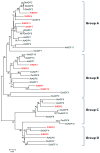Genome-Wide Identification, Characterization and Expression Profiling of ADF Family Genes in Solanum lycopersicum L
- PMID: 27690110
- PMCID: PMC5083918
- DOI: 10.3390/genes7100079
Genome-Wide Identification, Characterization and Expression Profiling of ADF Family Genes in Solanum lycopersicum L
Abstract
The actin depolymerizing factor (ADF) proteins have growth, development, defense-related and growth regulatory functions in plants. The present study used genome-wide analysis to investigate ADF family genes in tomato. Eleven tomato ADF genes were identified and differential expression patterns were found in different organs. SlADF6 was preferentially expressed in roots, suggesting its function in root development. SlADF1, SlADF3 and SlADF10 were predominately expressed in the flowers compared to the other organs and specifically in the stamen compared to other flower parts, indicating their potential roles in pollen development. The comparatively higher expression of SlADF3 and SlADF11 at early fruit developmental stages might implicate them in determining final fruit size. SlADF5 and SlADF8 had relatively higher levels of expression five days after the breaker stage of fruit development, suggesting their possible role in fruit ripening. Notably, six genes were induced by cold and heat, seven by drought, five by NaCl, and four each by abscisic acid (ABA), jasmonic acid (JA) and wounding treatments. The differential expression patterns of the SlADF genes under different types of stresses suggested their function in stress tolerance in tomato plants. Our results will be helpful for the functional characterization of ADF genes during organ and fruit development of tomato under different stresses.
Keywords: ADF gene; Solanum lycopersicum; abiotic stress; fruit development; organ-specific expression; phytohormone treatment.
Conflict of interest statement
The authors declare no conflict of interest exists.
Figures






References
LinkOut - more resources
Full Text Sources
Other Literature Sources
Research Materials

